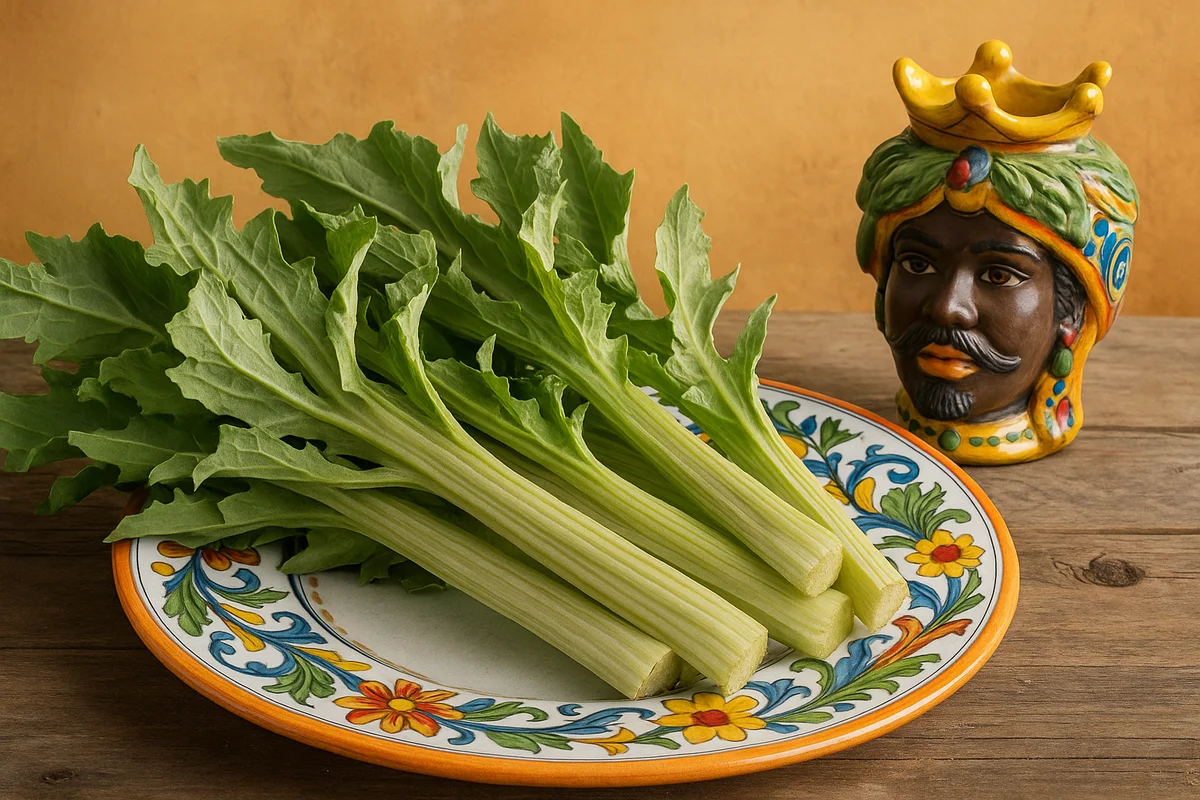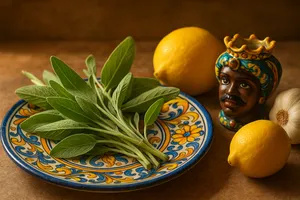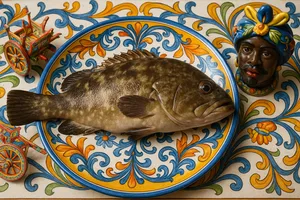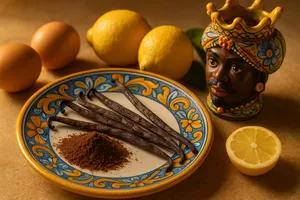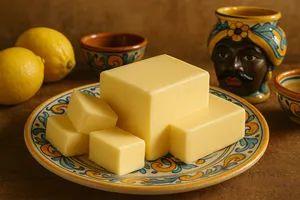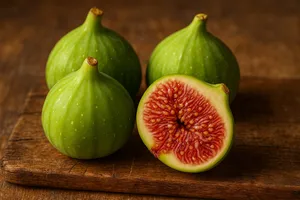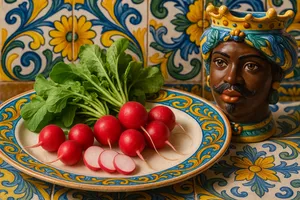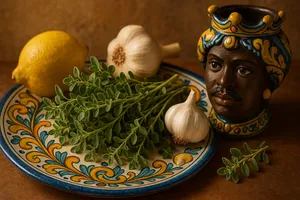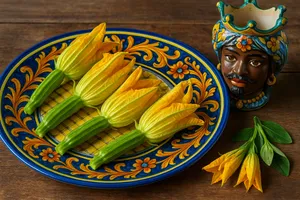Overview
Cardoons, known in Sicilian as “carduna”, belong to the same family as artichokes, with which they share many features. They are herbaceous plants whose fleshy leaf stalks are eaten; visually reminiscent of celery but larger, with a more pronounced, slightly bitter, aromatic flavour. In traditional Sicilian cookery, cardoons hold an important place, especially in winter dishes and festive Christmas preparations.
Cultivated on the island since antiquity, cardoons epitomise the resourcefulness of Sicilian peasant cuisine, which has long valued this versatile vegetable in both simple and elaborate dishes. Their presence is particularly significant in the cooking of Palermo and Catania, where family recipes are passed down that make this vegetable the star of memorable dishes.
Characteristics
Cardoons grow as large heads with fleshy, elongated, flattened stalks, white-silver or pale green depending on the variety and blanching. The stalks can reach 60–80 centimetres and have fibrous outer ribs that must be removed before cooking.
The flavour is delicate yet distinctive, with a gentle bitterness reminiscent of artichoke, balanced by a natural sweetness. The texture is crisp when raw, becoming soft and silky once cooked. The aroma is fresh and herbaceous with clean vegetal notes.
High-quality cardoons have wide, fleshy stalks, well blanched and free of excess fibres. The inner stalks, more tender and pale, are the most prized, while the outer stalks are more fibrous and bitter.
Varieties
Gobbo cardoon
A particularly prized variety, characterised by curved, very tender stalks. The plants are bent during growth. It has an exceptionally delicate flavour and very few fibres.
Riccio cardoon
Features crinkled leaves and wide, fleshy stalks. It is the most common variety in Sicily, appreciated for its rusticity and productivity.
Pieno inerme cardoon
A spineless variety with very wide, full stalks. It is the preferred choice for gratins and baked preparations.
Seasonality
In Sicily, cardoons are typically an autumn–winter vegetable. The best season runs from November to March, with peak quality and production between December and February. Cardoons harvested after the first frosts are particularly tender and sweet, as the cold transforms part of the starches into sugars.
During the Christmas period, cardoons feature prominently on Sicilian tables, prepared according to family recipes passed down through generations. In spring the plant flowers and the stalks become too fibrous and bitter to eat.
Use in the kitchen
In Sicilian cooking, cardoons appear in numerous traditional dishes.
Gratin cardoons
A classic preparation, especially at Christmas. Boiled cardoons are arranged in a baking dish, sprinkled with breadcrumbs, cheese, garlic, and parsley, then baked until golden. Some add béchamel for a richer version.
Fried cardoons
The stalks are boiled, cut into pieces, dipped in batter, and fried in abundant oil. This is typical of western Sicily, served as an antipasto or side dish.
Cardoon soup
Rustic soups in which cardoons are cooked in broth with legumes, pasta, or grains. In some areas, a cardoon soup with fresh ricotta is prepared—a humble yet hearty dish.
Stewed cardoons
Cardoons are cooked in a pan with tomatoes, garlic, olives, and capers, creating a flavourful side dish. Variations may include anchovies or sausage.
Frittatas
Boiled and chopped cardoons are mixed with eggs to prepare rustic frittatas, often enriched with cheese and onion.
Cleaning and preparation
Cleaning cardoons requires time but is straightforward. Remove the leaves, keeping only the fleshy stalks. With a small knife, strip away the fibrous outer ribs as you would with celery, pulling gently downward.
The cleaned stalks should be immediately immersed in acidulated water with lemon to prevent browning. Cut them into pieces (typically 5–7 cm) and boil in abundant salted water acidulated with lemon juice for 30–60 minutes, until tender but not mushy.
A traditional Sicilian trick is to add a spoonful of flour to the cooking water, which helps keep the cardoons white and reduces bitterness. Once boiled, they are ready for use in various preparations.
Storage
Fresh cardoons keep in the refrigerator for 4–5 days in the vegetable drawer, wrapped in a damp cloth or perforated paper bag. Do not wash before storing, as excess moisture accelerates deterioration; wash only before use.
Boiled cardoons keep for 2–3 days in the refrigerator in a sealed container, covered with their cooking water or a little oil. They freeze very well: once boiled and drained, they can be frozen in food bags and kept for 6–8 months.
Tips for buying
When buying cardoons, choose heads with fleshy, firm, tightly packed stalks, white-silver or light green. The stalks should be crisp, not limp or wilted. Avoid cardoons with dark spots, mouldy areas, or excessively fibrous stalks.
The heaviest cardoons relative to size are usually best, as they have more substantial stalks. The central part, paler and more tender, is the most prized. When shopping, bend a stalk slightly: if it snaps cleanly, it is fresh and tender.
Prefer local and seasonal cardoons. Those harvested after the first cold spells are sweeter and less bitter.
Nutritional properties
Cardoons are a very light vegetable: 100 grams provide only about 20 calories. They are over 90% water, with very low fat and protein content. They are rich in fibre, which supports digestion and satiety.
They offer good amounts of vitamin C, important for the immune system, and B vitamins. They also contain vitamin K, essential for blood clotting.
Cardoons are a good source of minerals, particularly potassium, calcium, iron, and magnesium. They contain cynarin, the same compound found in artichokes, with digestive, diuretic, and liver-supporting properties. In Sicilian folk tradition, cardoons were considered purifying and were eaten after festive indulgences.
Curiosities
In Sicilian tradition, cardoons were regarded as “the poor man’s food” because they grew abundantly in gardens and uncultivated land, offering a generous harvest with little care. Despite this humble background, they also graced noble tables, prepared in refined ways.
An old Sicilian saying goes: “A carduna è like people, the best part is inside,” referring to the tender, sweet heart hidden beneath the more fibrous, bitter outer stalks—a metaphor for deceptive appearances.
In Palermo, a traditional Christmas recipe called “cardoons in bone broth” is prepared: cardoons are cooked in a rich beef bone broth, creating a hearty, aromatic first course once cherished in cold winter days.
In folk tradition, the milky sap released from freshly cut cardoons was used to curdle milk in artisanal cheesemaking. This practice, once common in rural Sicily, is now rare but attests to the versatility of this vegetable.
During the Arab period, cardoons were cultivated in the gardens of Sicilian convents, where nuns perfected blanching techniques that involved tying the plants and covering them with earth or straw to make them more tender and less bitter. These techniques are still used by some traditional growers.

